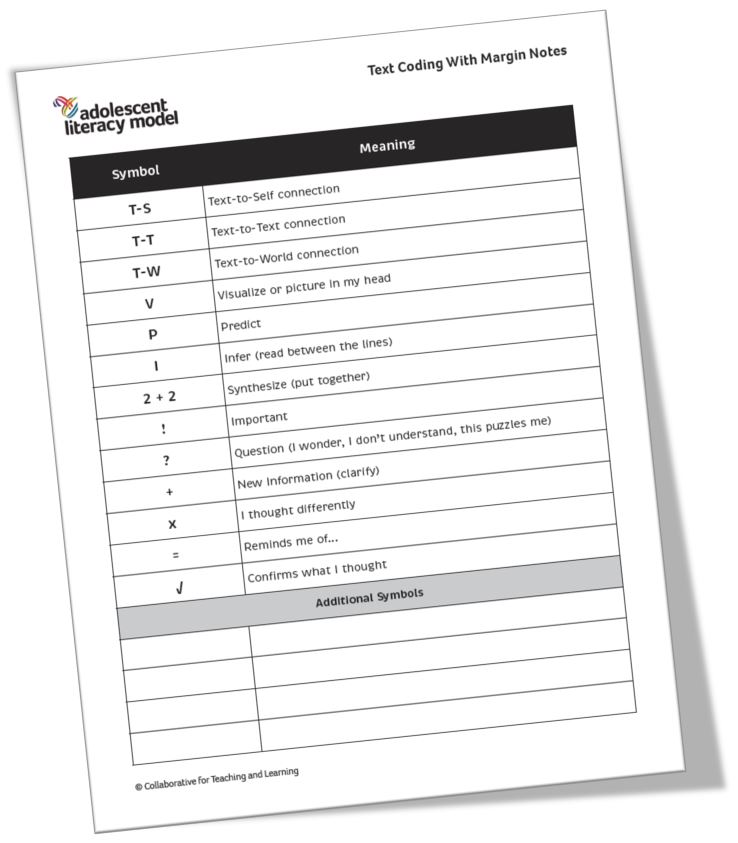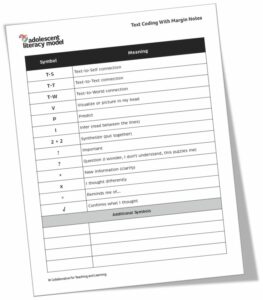STRATEGY FOCUS
TEXT CODING WITH MARGIN NOTES
Text Coding With Margin Notes is a form of annotating text that helps students track their thinking while they read. Students use a simple coding system to mark the text and record in writing what they are thinking. As students make connections, self-question, and respond to what they read, they are self-monitoring their comprehension and enhancing long term understanding. The codes help students name and remember a particular thinking strategy and track the thinking throughout the text. It’s important to select symbols that make sense for what students are being asked to read, the subject matter at hand, and the task that will be required of them following the reading. Symbols can be taught or used in isolation as appropriate for the purpose and content of the reading. Once students code a word or portion of text, they elaborate on their thinking by writing notes in the margin or explaining their use of a given code.

- Provide students with copies of the text to be read and a chart of the Text Code symbols to use.
- Go over the symbols for the Text Codes so that they make sense to the students and will be helpful as students go back and review the text and their Text Codes.
- Explain expectations for Margin Notes – elaborate on one’s thinking, ask questions, make predictions, respond to the text.
- Model the use of Text Codes With Margin Notes by reading and thinking aloud to show students how the codes and notes reflect how a reader engages with text.
- Allow students to practice on their own with a paragraph or two. Debrief the process so they can ask questions or share their work before going more deeply into the text.
- As students are more comfortable with the Text Codes With Margin Notes, assign the text to be read and ensure they have all needed materials to engage in the process.
- Are there patterns I can see in my Text Codes and Margin Notes?
- How will I use my Text Codes With Margin Notes to deepen my understanding of the text?
- After reading the text, are there additional Text Codes I could use that would be helpful?
- To be most effective, students will need their own copies of the text to be able to add Text Codes and write in the margins. If this is not possible, they can use sticky notes to record their text codes and margin notes. If students are using a digital text, they will need to be able to use a comment feature within the text.
- Teachers can then examine students’ Text Codes With Margin Notes to assess engagement with the text and reflection as well as any possible misunderstandings.
- As students become more familiar with Text Coding, they may be tempted to code their text only, without adding Margin Notes. Continue to encourage students to elaborate on their thinking by including Margin Notes in their process. Not only will their reading comprehension be enhanced as they make these notes, but when students return to the text at a later date, they will rely on these notes to make sense of their initial coding.
CONTENT APPLICATIONS

ENGLISH/LANGUAGE ARTS
Students use Text Codes With Margin Notes as they read a short story. They are instructed to specifically pay attention to the author’s use of imagery throughout the story.

ARTS & HUMANITIES
After listening to a recording of Aaron Copland’s Appalachian Spring, students read two different reviews and use Text Codes With Margin Notes to react to the writers’ interpretations and identify points of agreement and disagreement.
![]()
HEALTH & PHYSICAL EDUCATION
In preparation for a unit on archery, students read a rulebook for the sport using Text Codes With Margin Notes to engage with new learning and vocabulary specific to the sport.
![]()
SCIENCE
While reading an article from a scientific journal about genetic mutations, students use Text Codes With Margin Notes to make connections to what they have learned throughout the genetics unit.
PDF REPRODUCIBLE

